
Simply put, watch complications refer to any function on a watch beyond the simple display of hours, minutes, and seconds.
But if so basic…why do watch complications seem, well—for lack of a more creative term—so complicated?
Historically, luxury watch brands have used complications to differentiate themselves in a saturated industry. Patek Philippe, in particular, has been a pioneer, introducing innovations that have set benchmarks in the watchmaking industry.
In this article, we’ll address the many different types of watch complications to help you determine which to look out for in your next purchase.
Pssst…for more on how to choose a luxury timepiece, see our ultimate watch guide.
Date Complications: Taking time-keeping one tick further
Date Display
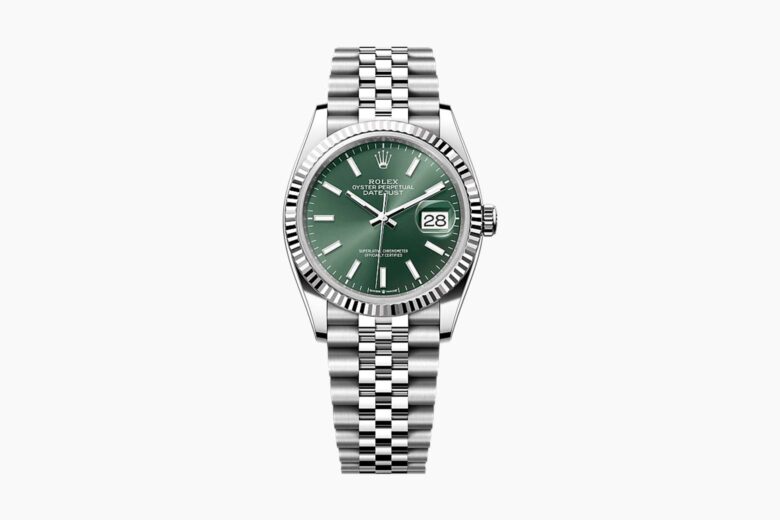
Providing the current date alongside the time, the date display is arguably the most ubiquitous watch complication. The genesis of the date complication traces back to 1915, introduced by Rolex. A quintessential example featuring this complication is the Rolex Datejust, renowned for its elegance and precision.
This practical feature varies from the simple date window, typically positioned at the 3 o’clock mark, to more elaborate forms like the day-date display and the annual or perpetual calendar. However, among the different types, the single date display remains the most common.
| As seen in: | Rolex Datejust |
| First appeared in: | 1915 |
Day-Date

The day-date display complication enriches the functionality of timepieces by showing not only the date but also the day of the week. This feature is particularly common in business and dress watches, offering a balance of utility and sophistication.
The display can vary, with some models presenting the day and date side by side, while others opt for a more integrated approach. Rolex pioneered this complication with the introduction of the Rolex Day-Date in 1956, setting a benchmark for designer watches. The Rolex Day-Date itself, often referred to as the “President’s watch,” is iconic for its culmination of practicality and prestige.
| As seen in: | Rolex Day-Date |
| First appeared in: | 1956 |
Full Calendar Complications: The day, the month, the year
Triple Calendar
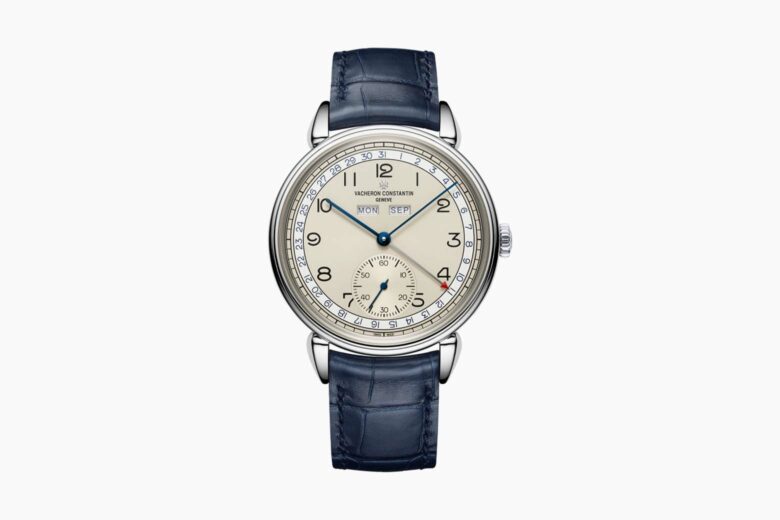
The triple calendar display complication is a sophisticated feature that provides a comprehensive overview of the date, showcasing the day of the week, the date of the month, and the month itself. This complication is typically found in more refined timepieces or dress watches.
The variations of this complication include the simple triple calendar, which requires manual adjustment for months with fewer than 31 days, and the more advanced annual and perpetual calendars, which account for these variations automatically.
The first watches with a Triple Calendar display began appearing in the early 20th century, with one notable example being the Vacheron Constantin Triple Calendar, introduced in 1942.
| As seen in: | Vacheron Constantin Triple Calendar |
| First appeared in: | 1942 |
Annual Calendar

Introduced by Patek Philippe in 1996, the annual calendar complication marked a significant advancement in watchmaking technology. The display is designed to accurately account for the varying lengths of months throughout the year, requiring manual correction only once a year at the end of February.
It typically displays the day, date, and month, distinguishing itself from simpler calendar complications by its ability to handle months with 30 and 31 days automatically. The Patek Philippe Annual Calendar (Ref. 5035) was the first to feature this innovation, setting a precedent for future generations of timepieces with this complex function.
| As seen in: | Patek Philippe Annual Calendar |
| First appeared in: | 1996 |
Perpetual Calendar

First introduced in 1925, the perpetual calendar display complication is one of horology’s most esteemed achievements. It is designed to accurately indicate the date, day, month, and often the phase of the moon, while automatically accounting for leap years.
This means it can distinguish between months of varying lengths and requires no manual adjustment until 2100, due to the secular exception in the Gregorian Calendar.
The first-ever example of this complication is the Patek Philippe Grand Complications Perpetual Calendar (Ref. 5327J), a legacy piece that can accurately keep time throughout centuries.
| As seen in: | Patek Philippe Grand Complications Perpetual Calendar |
| First appeared in: | 1925 |
Travel Complications: Keeping track across continents
GMT

The GMT display complication allows to track two or more time zones simultaneously. It typically features an additional hour hand that completes one rotation every 24 hours, paired with a bezel or inner dial marking the 24-hour scale, to indicate a second time zone.
The GMT complication first appeared in 1954 with the Rolex GMT-Master, showcasing the evolution of this practical complication for global connectivity. Common in both luxury watches and practical timepieces, variations include fixed and rotatable bezels for added functionality.
| As seen in: | Rolex GMT-Master |
| First appeared in: | 1954 |
Dual Time

The dual time display complication offers the convenience of displaying a second time zone, distinct from the GMT function by typically featuring a separate dial or sub-dial to show the hours and sometimes minutes of an alternative time zone. The dual time complication can vary in its presentation, from analog sub-dials to digital displays.
While its origins are not as clearly defined as some other complications, the concept has been around since the mid-20th century. An iconic model featuring this complication is the Patek Philippe Calatrava Pilot Travel Time (Ref. 5524G).
| As seen in: | Patek Philippe Calatrava Pilot Travel Time |
| First appeared in: | Mid-20th century |
World Timer
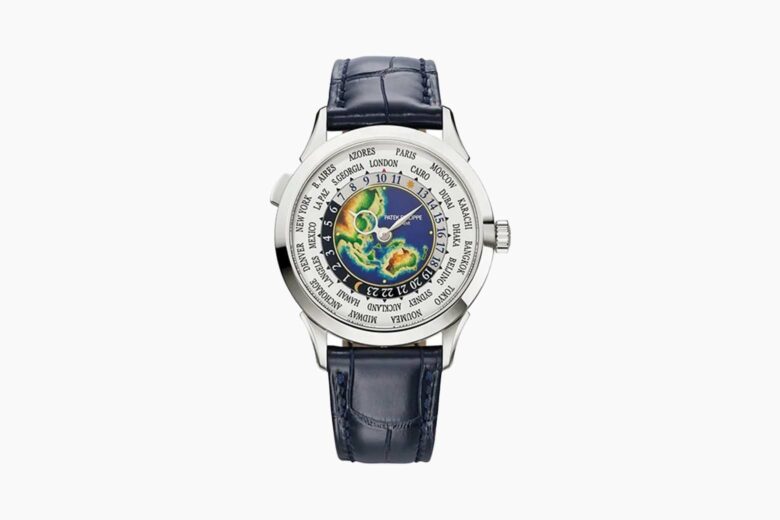
Typically featuring a rotating bezel or inner dial marked with the names of major cities representing each time zone, the world timer complication allows the wearer to view the time in multiple time zones around the world at a glance.
While the first world timer watch was created by Louis Cottier in the 1930s, a more well-known example of this display is the Patek Philippe World Time (Ref. 5230G), which displays the time in 24 time zones with unmatched elegance and precision.
| As seen in: | Patek Philippe World Time |
| First appeared in: | 1930s |
Chronographs: Ready, set, go
Simple Chronograph

The Simple Chronograph complication allows for the measurement of short periods of time with the press of a button, independent of the watch’s main timekeeping function. It displays elapsed time, typically through a central seconds hand and smaller sub-dials for minutes (and sometimes hours) counted.
The first chronograph was invented in 1816 by Nicolas Mathieu Rieussec and is now a common feature in many sports and luxury watches, including the Omega Speedmaster Professional (“Moonwatch”), known for its precision, durability, and historical significance in space exploration.
| As seen in: | Omega Speedmaster Professional |
| First appeared in: | 1816 |
Flyback Chronograph

The Flyback Chronograph complication allows to reset and restart the timing function with a single push, without the need to stop, reset, and restart separately. This feature is particularly valued in aviation and sports timing, where speed and efficiency are crucial.
First introduced in the 1930s for use in aviation, it represents a significant advancement in chronograph technology, as seen in the high-performance Blancpain Fifty Fathoms Flyback Chronograph.
| As seen in: | Blancpain Fifty Fathoms Flyback Chronograph |
| First appeared in: | 1930s |
Split-Seconds
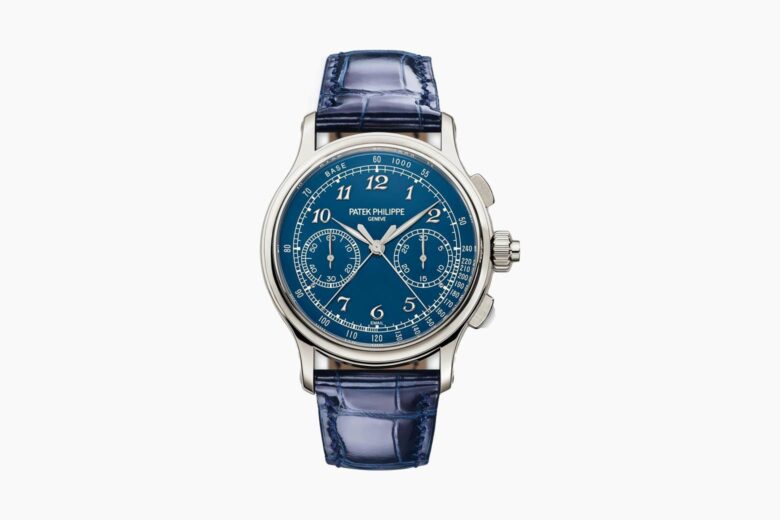
The Split-Seconds Chronograph, also known as a Rattrapante, offers the intricate ability to measure multiple events of different durations simultaneously, thanks to its two superimposed seconds hands.
This complication displays elapsed time like a standard chronograph, but one hand can be stopped independently to record an intermediate time while the other continues running.
The concept dates back to the late 19th century as the pinnacle of mechanical ingenuity, with a prominent example being the Patek Philippe Split-Seconds Chronograph (Ref. 5370P).
| As seen in: | Patek Philippe Split-Seconds Chronograph |
| First appeared in: | Late 19th century |
Moonphase

Bridging horology with astronomy, the moonphase display illustrates the current phase of the moon as it waxes and wanes. Moonphase watches can range from simple representations to more complex systems that indicate additional lunar details.
While this complication has been adorning Grandfather clocks since the 16th century, it was first engineered for a wristwatch in 1925 by Patek Philippe. Today, a distinguished example of the display is the Jaeger-LeCoultre Master Ultra Thin Moon, which showcases the moonphase in a sub-dial, complemented by its date display.
| As seen in: | Jaeger-LeCoultre Master Ultra Thin Moon |
| First appeared in: | 1925 |
Tourbillon

By mounting the escapement and balance wheel in a rotating cage, the tourbillon complication is designed to counteract the effects of gravity on the accuracy of a watch. Often visible through an aperture on the watch’s dial or caseback, it is a symbol of enhanced precision and excellent craftsmanship.
Invented in 1795 by Abraham-Louis Breguet, the tourbillon remains a hallmark of horological evolution. The Breguet Classique Complications Tourbillon (Ref. 5377) beautifully exemplifies this, showcasing the high-end watch brand’s innovation and elegance in a slender profile.
| As seen in: | Breguet Classique Complications Tourbillon |
| First appeared in: | 1795 |
Retrograde

As one of the more unique watch complications, the Retrograde display offers a distinct approach to displaying time or calendar functions. Rather than rotating in a continuous circle, hands move along a scale and snap back to the starting point upon reaching the end.
Retrograde displays come in various forms, from single to multiple retrograde indicators on one dial. This visually engaging mechanism can display seconds, minutes, hours, dates, or even months, adding a dynamic element to the watch face.
Vacheron Constantin pioneered the use of a retrograde dial-in wristwatches, a milestone achieved as early as the 1930s. Today, a beautiful example of this complication is the Van Cleef & Arpels Pont des Amoureux, incorporating a retrograde display into a romantic narrative.
| As seen in: | Van Cleef & Arpels Pont des Amoureux |
| First appeared in: | 1930s |
Power Reserve Indicator
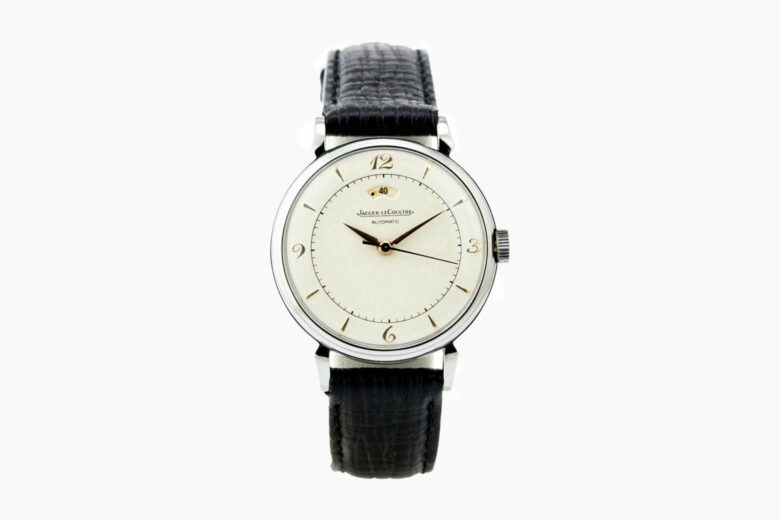
A common feature in smartwatches, the power reserve indicator complication provides a visual representation of the remaining energy available in a watch’s mainspring. The indicator can vary from a simple gauge to more elaborate displays.
The initial prototype watch featuring a power reserve was developed by Breguet in 1933. However, the first power reserve indicator watch intended for mass production was launched by Jaeger-LeCoultre in 1948, specifically for their Powermatic collection.
| As seen in: | Jaeger-LeCoultre Powermatic collection |
| First appeared in: | 1933 |
Sounds: For when you can’t just keep an eye on the time
Minute Repeater

The minute repeater complication is a sophisticated mechanism that audibly chimes the hours, quarters, and minutes upon the wearer’s request. Minute repeaters can vary in their chime sequences and sound quality, with some incorporating unique melodies.
The first known minute repeater was created in 1892 by the Brandt brothers, founders of OMEGA watches. Minute repeaters were initially developed to aid those with visual impairments. And, before the widespread adoption of electricity, they also enabled people to discern the time in the dark.
| As seen in: | Patek Philippe Grand Complications Minute Repeater |
| First appeared in: | 1892 |
Mechanical Alarm

The mechanical alarm complication emits an audible alert at a set time, serving as a personal reminder or wake-up call. This feature is found in a variety of watches, from practical daily wear smartwatches to more luxurious designer models.
Mechanical alarms vary in their sophistication. Some offer a simple single alarm setting, while others may include multiple alarms or additional features like a snooze function.
The first known mechanical alarm watch was introduced by Vulcain in 1947 and is now a common complication in watches like the Jaeger-LeCoultre Memovox.
| As seen in: | Jaeger-LeCoultre Memovox |
| First appeared in: | 1947 |
Other watch terms to know
While not technically classified as complications, many categorize them as such, which is why we thought we’d mention them separately.
Grand Complication
The term “Grand Complication” refers to a watch with several complications. Typically, a Grand Complication watch includes a combination of timing (like a chronograph), astronomical (like a perpetual calendar), and striking complications (like a minute repeater).
The concept of Grand Complications has evolved over time, with the criteria broadening as watchmaking advances. The first watches to be considered as having Grand Complications emerged in the late 19th and continued to progress throughout the 20th century.
Tachymeter Scale
The Tachymeter Scale is a feature designed to measure speed over a fixed distance, using the chronograph function of a watch. It displays the speed in units per hour, based on the time taken to cover the distance and is commonly found on the bezels or outer dials of sports and racing watches.
This feature first appeared in the early 20th century, gaining popularity among aviators and automobile racers. The Omega Speedmaster Professional, famously known as the “Moonwatch,” is a classic example that features a tachymeter scale, embodying its deep-rooted association with speed, precision, and exploration.
Telemeter
The Telemeter feature is a scale used in conjunction with a watch’s chronograph function to measure the distance of an event based on the speed of sound. It displays the distance to an event, such as lightning or artillery fire, observed by starting the chronograph upon seeing the event and stopping it when the sound is heard; the telemeter scale then indicates the distance to the event.
Commonly found on military and pilot watches, telemeter scales can vary in their measurement units, but all serve the purpose of distance calculation. This feature first made its appearance in wristwatches during the early 20th century, catering to military and scientific needs.
Frequently asked questions about watch complications
The most common watch complication is undoubtedly the date display. This feature, which shows the current date, is found across a wide range of timepieces, from affordable everyday watches to high-end luxury models. Check our article for more on the most popular watch complications.
The Vacheron Constantin Reference 57260 is the watch with the most complications. This horological masterpiece boasts 57 complications, including multiple timekeeping functions, calendars, and astronomical indicators. Commissioned by a private collector and crafted by three master watchmakers over eight years, it represents the pinnacle of watchmaking skill and innovation.
Smartwatch complications refer to customizable widgets or display features on the watch face. Some of the best Apple watch complications provide quick access to information or apps, such as weather forecasts, fitness tracking, calendar events, or notifications. These digital complications enhance the functionality of a smartwatch, allowing users to tailor their devices to their personal needs and preferences.
The Rolex Sky-Dweller is among the Rolex models with the most complications. With a list of watch complications, it features both an annual calendar and a 24-hour GMT display. This combination allows it to simultaneously display the time in two time zones and automatically adjust the date for months with fewer or more days.
